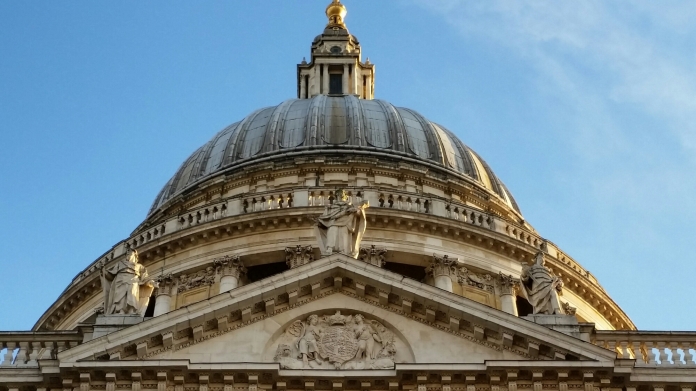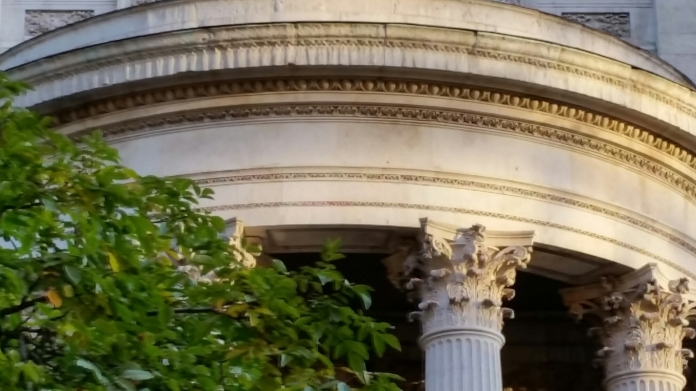I was intrigued as to who had been responsible for the statues of the apostles standing on the parapet of the north transept of St. Paul’s, nearly invisible from the ground. The answer is Francis Bird, described by George Vertue as ‘the most famous statuary, that this Nation ever bred’. I should have known about him. He was trained both in Flanders, where he was apprenticed aged 11, and in Rome, where he worked under Pierre Legros, learning to carve the ornaments of baroque churches. His first work for St. Paul’s was a relief of St. Paul preaching to the Bereans over the west door and he was then invited to do the carving of the Conversion of St. Paul in the tympanum of the west front. Then he did the statue of Queen Anne to celebrate the completion of St. Paul’s. The statues on the transepts belong to a later phase of work when a New Commission was appointed using John James as architect, not Wren. In fact Wren vehemently objected to their work, as recorded in a letter to the Commission dated 28 October 1717, not long before his death: ‘I never designed a balustrade. Persons of little skill in architecture did expect, I believe, to see something they had been used to in Gothic structures; and Ladies think nothing well without an edging…My opinion, therefore, is, to have statues erected on the four pediments only, which will be a most proper, noble and sufficient ornament to the whole fabric, and was never omitted in the best ancient Greek and Roman architecture’. They went ahead and commissioned the sculptures nonetheless, even though Bird was a Catholic.
Monthly Archives: October 2015
Southwark
Years ago, we lived in Southwark, in an attic flat in Trinity Church Square, painted bright blue, with paint from a shop just north of the Elephant and Castle. The surrounding area was deeply dingy, little known streets, cheap housing, sandwiched under the railway tracks between London Bridge and Waterloo. Today I crossed Blackfriars Bridge at lunchtime, visited Purdy Hicks in Hopton Street, saw the exhibition by Julian Stair at Contemporary Applied Arts (pots for £36,000) and had lunch at The Table in Southwark Street, designed, I presume, by Allies and Morrison.
Eva Jiřičná RA
We went to a lecture tonight by Eva Jiřičná. Although I have followed her career fairly closely and have always admired her glass staircases and precision engineering – she designed the Royal Academy’s shop – I hadn’t realised the full range and depth of her career, including a great deal of work at the V&A, the doors at the entrance, the desk and the shop, as well as the Bollinger jewellery gallery, shops, including work for Joseph (she did the original design for the Caprice), as well as work in Prague and Zlin, her home town in Czechoslovakia. Best of the work she showed was a house she has designed for a property developer in Czechoslovakia, which looks like a sputnik and is mostly underground, but demonstrates her amazing neo-modernist sense of space age geometry.
Smithfield Market
I walked past Smithfield Market yesterday and stopped to admire Horace Jones’s great cast iron buildings (he also designed Leadenhall and Billingsgate). It opened in 1868, although the area had been used as London’s major livestock market since the twelfth century at least. Smooth field as it was known:-
The North Transept
I had a meeting yesterday in an office which overlooks the north transept of St. Paul’s. I have always thought of St. Paul’s as a cool, rather rational building, the product of Wren’s abstract and mathematical mind (see the biography by Lisa Jardine which is as much about him as a scientist as an architect). But seen up close it is pure Roman baroque, devoted to the glories of post-Fire reconstruction and the grandiosity of late seventeenth-century London’s commercial success:-
King’s Bench Walk
I have always found the Temple insuperably confusing, apart from the tube station. Where does the Inner Temple become the Middle Temple ? Who has chambers where and what is their pecking order ? How much of it is original (not much) and how much postwar reconstruction ? But now that I have to go back and forth between Blackfriars and Piccadilly several times a week, I am gradually learning my way around. The bit I like best is King’s Bench Walk which at least looks original, not a neo-Georgian pastiche. No. 4 is said to be by Wren (do I believe this ?) and was built after the fire of 1677 (no, that is not a misprint):-
The Society of Artists
In clearing out the sculpture store in the basement of Burlington Gardens, our collections staff discovered a cache of papers described as Artists’ Memorabilia. They alerted our archivist. It included the Roll of Obligation of the Society of Artists, the antecedent body which broke up in a succession of disputes as to how it was run, prompting a small group of four, led by William Chambers, going to see George III to establish the Royal Academy. The Roll of Obligation hasn’t been seen or known to scholars since the 1920s. It includes Chambers’s name and those of all the rebels scratched out in high dudgeon when they left the Society. Reynolds’s name is a long way down the list:-
Gainsborough is higher up:-
Carnet de Voyage
We celebrated the start of building work in Burlington Gardens last week with a performance tonight by the two person performance group, Carnet de Voyage. I wasn’t quite sure what to expect. It was a combination of classical music, piano and jazz, arranged and performed by Rosey Chan and Mimi Xu to a backdrop of short films by Mike Figgis, who also played the trumpet. The idea was to demonstrate that it is possible to devise new conventions in performance and the relationship between the arts and that anything is possible in the new building.
45, Jermyn Street
I happened to be walking past the old Fountain Restaurant underneath Fortnum and Masons this evening and discovered that it was the first night of its new incarnation as 45 Jermyn Street, ultra smart and posh traditional, by Martin Brudnizki, the Swedish designer who did Scotts on Mount Street, has totally transformed the fortunes of the Royal Academy’s Academician’s Room, and has now radically changed the old haunt of afternoon tea and knickerbocker glories:-
Lisa Jardine
I have just been listening to Peter Hennessy talk about the loss of Lisa Jardine on the Today programme. I saw her for the last time on Friday. It was unspeakably sad to see someone who was always so wonderfully and life enhancingly funny and ebullient with the life nearly completely drained away. I sat with her and thought of all the many times I had seen her over the years: how furious she was with me when she was not made a Trustee of the National Gallery; how helpful she was when I was thinking of leaving the National Gallery; sitting in the garden at home and her talking about her father. Thinking also about her contributions to scholarship, her work on Francis Bacon, her biography of Wren and the Royal Society, on Anglo-Dutch cultural relations. She was a force of nature.





















You must be logged in to post a comment.